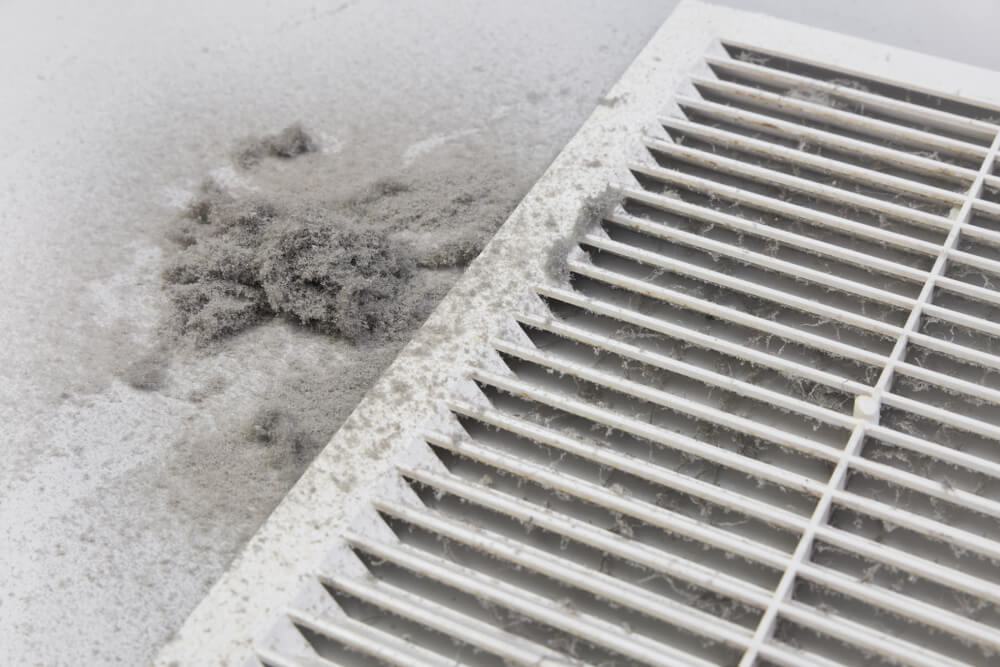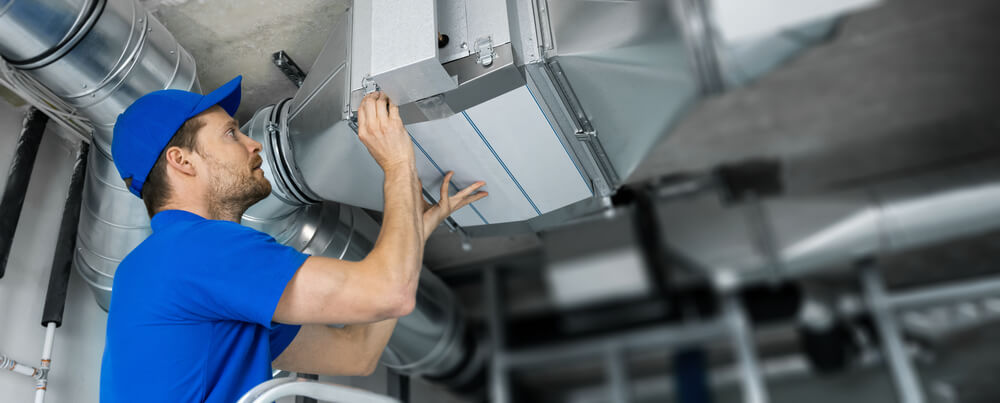Your health is directly related to the indoor air quality around you. The presence of dust particles, irritants, pollen or mold spores in your air conditioning systems can be extremely dangerous to inhale.
Like any other HVAC system, air ducts require regular maintenance to ensure maximum efficiency. Here a question arises: how to clean the air ducts?
As a general rule of thumb, the National Air Duct Cleaners Association (NADCA) recommends air duct cleaning every 3 to 5 years.
What is air duct cleaning?
Duct cleaning generally refers to the cleaning of various heating and cooling system components of forced air systems.
Air ducts are passageways that transport cooled and heated air throughout your house. Just like any other HVAC system, air duct cleaning and regular maintenance ensure maximum efficiency. If not cleaned timely, the accumulated dust and dirt get filled with contaminants and air pollutants that can not only harm your indoor air quality but can also cause your HVAC system to work harder.
Consequently, this not only increases your energy bills, but can also significantly shorten the life expectancy of your system.
Your home’s cooling system will perform better with regular maintenance, and air duct cleaning to ensure the longevity of your entire HVAC system.
When to Clean The Air Ducts?

If you are uncertain about when to clean your air ducts and how often you should do it, here are some common signs of dirty air ducts which can cause duct problems in the long run.
Ducts clogged with dust and debris
In normal situations, air ducts do not expel visible dust or debris when the heating and cooling system is switched on, and the air starts to flow through the ducts. Therefore, if you see a visible presence of dust, it is probably a clear sign of dirty air ducts.
Dusty surroundings
If you notice:
- Your home or commercial area seems dusty.
- Every surface is coated with dust immediately after cleaning the area.
- If you notice dust coming out of the vents every time the HVAC system kicks on.
These are signs of dirty ducts. You probably need to have your ducts cleaned.
Remove a vent cover filter and take a look at the ductwork. If the metal is covered in dust and you see dust and dirt both inside and outside your ducts most likely need to be cleaned.
Make sure you replace your HVAC system air filters frequently to prevent future dust buildups.
Ducts Infested with Insects
Even the cleanest homes can have dirt, dust, pet dander, and all sorts of harmful contaminants lingering in the air ducts. From time to time, mice, squirrels, rodents and insects can make their way into your air ducts. They leave behind all sorts of bacteria and droppings. This allows tiny faecal spores to sweep along the ducts. These spores can then make their way into your home and contaminate the quality of the air you breathe.
Keep in mind that a bacterial infestation might require more than air duct cleaning. If the issue is overlooked, it could lead to serious damage to the HVAC equipment as well as to the health. Moreover, an HVAC system that doesn’t work efficiently, leads to higher energy bills.
Frequently clogged filters
No doubt filters need to be changed periodically however, they shouldn’t be clogged after every few days of replacing them. If you have to change HVAC filters now and then this could be an indication of a deeper problem. This is a sign that you need to check on the air ducts.
Rising Energy Bills
Your heating and cooling costs should be relatively predictable from year to year. If you notice that your electricity bill has suddenly skyrocketed, dirty ductwork might be to blame.
With continuous use, the ductwork can accumulate with too much dirt that air can not flow freely and efficiently through your home’s HVAC system. Thus both your furnace and air conditioner are forced to work harder to maintain a comfortable indoor temperature. This causes higher utility bills for you and your family.
Related: Energy saving tips for your HVAC system
Unpleasant odor from ducts
Another evident sign of the presence of debris in your commercial or industrial HVAC duct system is the ducts emanating an unpleasant odor. It is a sign you should conduct serious ventilation system cleaning. It is best to consult an expert technician who can inspect the air ducts for anything that could be emitting a bad smell.
Strange and unusual noises in the ductwork
If you have lived in your home or owned a building or commercial area with an HVAC system installed, you know how the HVAC system sounds when it is operational. Your ductwork shouldn’t make a lot of noise while operating. If you hear anything more than the general motor sound, your ducts could be experiencing some problems.
Inadequate airflow
Air that travels through the ductwork should deliver relatively consistent airflow from room to room. If you notice that a bathroom, bedroom, or other room in your home doesn’t receive the same level of airflow as other rooms, inconsistency could be the reason. Dirty air ducts, accumulation of debris in your air ducts, and any leaks you have in your ductwork ultimately decrease the efficiency and increase your energy bill.
All of this causes your system to have to work harder. Hiring an air duct technician to clean your ducts won’t only remove harmful contaminants, but can also rule out potential leaks.
How to Clean the Air Ducts?
Cleaning air ducts is an important aspect of maintaining a healthy indoor environment. While some people may choose to hire professionals for this task, others may prefer a DIY approach. Here’s a general guide for cleaning air ducts:
Materials and Equipment:
- Screwdriver
- Duct cleaning brushes
- Vacuum cleaner with a hose and attachments
- Microfiber cloths
- Disposable dust masks
- Flashlight
Steps To Clean the Air Ducts
- Turn off the HVAC System:
- Ensure that your heating, ventilation, and air conditioning (HVAC) system is turned off before you start cleaning.
- Remove Vent Covers:
- Use a screwdriver to remove the vent covers from the ducts. Clean them separately with warm, soapy water and let them dry.
- Clean Duct Surfaces:
- Reach as far into the ducts as you can with a duct cleaning brush to dislodge dust and debris. Move the brush in a circular motion to scrub the surfaces.
- Vacuum the Ducts:
- Use a vacuum cleaner with a hose attachment to suck up the loosened dirt and debris. Ensure the vacuum has a HEPA filter to trap fine particles.
- Clean the Registers:
- Wipe down the inside of the registers using a microfiber cloth. You can use a mild cleaning solution if necessary.
- Inspect for Mold or Mildew:
- If you notice any signs of mold or mildew, consider using a solution of water and vinegar (or a mold-killing solution recommended by professionals) to clean affected areas.
- Check for Duct Damage:
- Inspect the ducts for any signs of damage or leaks. Repair or replace damaged sections as needed.
- Replace Vent Covers:
- Once the ducts are clean, reinstall the vent covers securely.
- Turn on the HVAC System:
- After completing the cleaning, turn the HVAC system back on and monitor its performance
Hire a Professional

If you are not sure when to clean your air ducts, it’s always good to call a professional. Cleaning your home’s air ducts is an intricate process and is not something you should attempt to do on your own. It’s a complex process that requires specialized tools and advanced knowledge of HVAC systems. Make sure you choose a qualified contractor to ensure the job is done right.
Alturas Los Angeles HVAC Contractors are skilled in providing all types of HVAC cleaning and maintenance services. We have professional HVAC air duct cleaners who use commercial-grade vacuum systems and powered brushes to loosen and remove dirt and debris from your home’s or commercial HVAC system. Our Air duct cleaning professionals are also trained to diagnose other hidden problems in an HVAC system that a homeowner may not be able to identify.
How to Clean the Air Ducts FAQs
How do I know if my air ducts need to be cleaned?
Many signs show that your air ducts need cleaning. Have your air ducts cleaned if:
- Are visibly contaminated with substantial mold growth, pests, or vermin.
- The ducts are clogged with substantial deposits of dust or debris.
- There is an inadequate airflow across the house.
- You hear strange noises from the duct or sense an unpleasant odor
- Your electricity bill has suddenly skyrocketed.
Can air duct cleaning cause damage?
If the cleaning is done properly, no evidence suggests that duct cleaning would be damaging. Ducts should be cleaned as required. But It is still best to call a professional duct cleaner to avoid any damage.
Can you clean your air ducts?
Cleaning air ducts is not a do-it-yourself job. It requires special tools, such as a high-powered vacuum and rotary brushes, that are not often found with everyone. Furthermore, an improper cleaning job could damage the ducts, resulting in expensive repairs. We recommend scheduling regular air duct cleaning services from a professional HVAC technician to keep your system in the best possible shape.
How Often Should You Clean the Air Ducts?
Experts advise having your air ducts cleaned every 2 to 3 years to prevent greater problems before they start. However, homes with pets or children with allergies or respiratory problems should have their air ducts professionally cleaned more frequently than the recommended average.
How to Clean the Air Ducts in Your Home?
To clean the air ducts:
- Turn off HVAC system
- Remove vent covers
- Vacuum debris
- Use brush or whip to dislodge dust
- Vacuum again
- Consider professional cleaning for thorough results
How Much Does it Cost to Clean the Air Ducts?
The cost to clean air ducts varies but typically ranges from $300 to $1,000. Factors influencing cost include duct complexity, size of the system, location, and the cleaning method used.
Should I Clean the Air Ducts in my Home?
Cleaning air ducts can be beneficial if there’s visible mold, excessive dust, or verifiable rodent/insect infestations. However, routine cleaning may not be necessary unless specific issues arise. Consult a professional for advice.
How Do They Clean the Air Ducts?
- Initial Inspection: Assess ducts for contaminants.
- Create Access Points: Open access points to reach the entire system.
- Cleaning Methods: Use tools like brushes, vacuums, or compressed air.
- Final Inspection: Ensure thorough cleaning, and seal access points.

